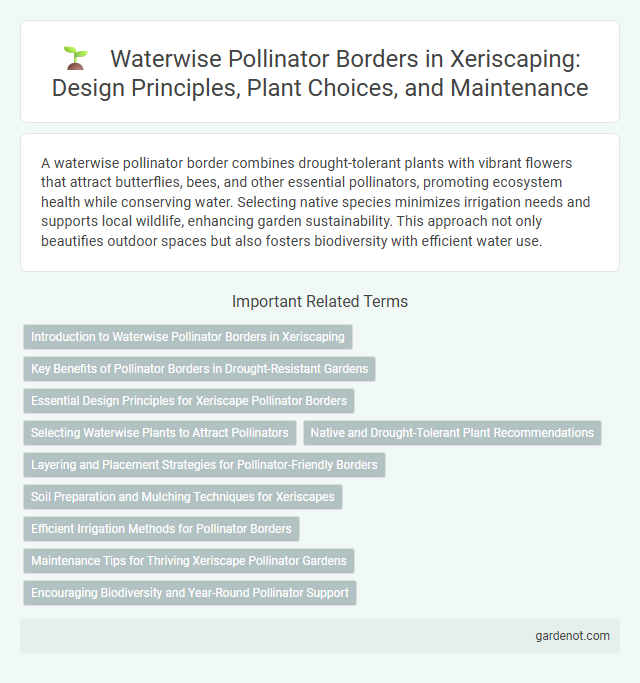A waterwise pollinator border combines drought-tolerant plants with vibrant flowers that attract butterflies, bees, and other essential pollinators, promoting ecosystem health while conserving water. Selecting native species minimizes irrigation needs and supports local wildlife, enhancing garden sustainability. This approach not only beautifies outdoor spaces but also fosters biodiversity with efficient water use.
Introduction to Waterwise Pollinator Borders in Xeriscaping
Waterwise pollinator borders in xeriscaping create sustainable habitats by using drought-tolerant plants that attract bees, butterflies, and hummingbirds while conserving water resources. These borders incorporate native wildflowers and shrubs adapted to arid climates, promoting biodiversity without excessive irrigation. Establishing a water-efficient pollinator border enhances ecosystem health and supports pollination essential for food production and native plant reproduction.
Key Benefits of Pollinator Borders in Drought-Resistant Gardens
Waterwise pollinator borders enhance xeriscape gardens by attracting essential pollinators like bees, butterflies, and hummingbirds, promoting biodiversity while conserving water. These drought-resistant plantings improve soil health and reduce irrigation needs by selecting native, drought-tolerant species adapted to arid conditions. Incorporating pollinator borders supports ecosystem resilience, increases fruit and seed production, and sustains local wildlife populations in water-scarce environments.
Essential Design Principles for Xeriscape Pollinator Borders
Waterwise pollinator borders in xeriscape gardens prioritize drought-tolerant native plants that support local pollinators while conserving water. Essential design principles include selecting a diverse range of flowering species that bloom sequentially to provide continuous nectar and pollen sources, and grouping plants with similar water needs to optimize irrigation efficiency. Incorporating structural elements like mulches and permeable hardscapes enhances moisture retention and reduces evaporation, promoting sustainable water management.
Selecting Waterwise Plants to Attract Pollinators
Choosing native, drought-tolerant plants such as lavender, salvia, and milkweed supports a sustainable waterwise pollinator border by attracting bees, butterflies, and hummingbirds while conserving water. These species thrive in xeriscape gardens by requiring minimal irrigation and offering nectar and pollen essential for pollinator health. Incorporating a diverse mix of flowering plants with staggered bloom periods ensures continuous food sources and enhances habitat biodiversity.
Native and Drought-Tolerant Plant Recommendations
Waterwise pollinator borders thrive with native and drought-tolerant plants such as purple coneflower (Echinacea purpurea), bee balm (Monarda fistulosa), and butterfly milkweed (Asclepias tuberosa), which attract bees, butterflies, and hummingbirds while conserving water. These species adapt to xeriscape conditions by requiring minimal irrigation and promoting soil health through deep root systems. Integrating native grasses like blue grama (Bouteloua gracilis) enhances the border's sustainability and supports local wildlife habitats.
Layering and Placement Strategies for Pollinator-Friendly Borders
Layering and placement strategies in waterwise pollinator borders maximize habitat diversity and resource availability, supporting a wide range of beneficial insects. Use a mix of native flowering plants with staggered bloom times arranged in vertical layers to provide continuous nectar and shelter throughout the growing season. Position pollinator plants near water sources and sunny areas to enhance accessibility and promote healthy pollinator activity in xeriscape gardens.
Soil Preparation and Mulching Techniques for Xeriscapes
Proper soil preparation for a waterwise pollinator border in xeriscapes involves loosening compacted soil and incorporating organic matter to improve moisture retention and aeration. Applying a thick layer of mulch such as shredded bark or gravel helps conserve water, suppress weeds, and regulate soil temperature. These techniques create an optimal environment for native pollinators by maintaining soil health and reducing irrigation needs.
Efficient Irrigation Methods for Pollinator Borders
Efficient irrigation methods for waterwise pollinator borders include drip irrigation and soaker hoses, which deliver targeted moisture directly to root zones, minimizing water waste. Utilizing mulch around plants helps retain soil moisture and regulate temperature, enhancing water efficiency. Smart irrigation controllers with moisture sensors adjust watering schedules based on weather data, optimizing water use while supporting pollinator health.
Maintenance Tips for Thriving Xeriscape Pollinator Gardens
Waterwise pollinator borders require minimal irrigation while supporting local ecosystems, making them ideal for xeriscape gardens. Regularly removing invasive weeds and deadheading spent flowers promotes healthy growth and prolonged blooming periods. Monitoring soil moisture and applying mulch helps retain water, ensuring vibrant pollinator activity with limited resources.
Encouraging Biodiversity and Year-Round Pollinator Support
A waterwise pollinator border incorporates drought-tolerant native plants that provide nectar and habitat for diverse pollinator species throughout the year. By selecting flowering plants with staggered bloom times, it ensures continuous food sources, promoting ecosystem resilience and biodiversity. This sustainable landscaping approach conserves water while supporting essential pollinator populations vital for local agriculture and natural habitats.
Waterwise pollinator border Infographic

 gardenot.com
gardenot.com